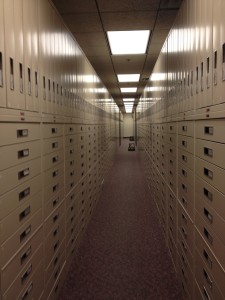
An aisle of microfilm at the Family History Library
I leave for Salt Lake City on Wednesday, to attend the RootsTech conference. I arrive noonish and have decided to spend the afternoon and early evening at the Family History Library. I’m finding myself wishing I’d opted to go a day early to research, but I didn’t, so I’m trying to make good use of the fairly narrow window of time at the library.
I’m really fortunate because professional genealogist and Organize Your Family History reader Maria Tello has offered to meet me at the library and get me oriented and off to the right start. Thank you, Maria!
I’m looking to keep myself focused on one nuclear family; I have some questions I’d like to get answered. But I don’t want to have such tunnel vision that I might miss out on opportunities to learn about other families.
I’m wondering if any of my readers have any advice for me. I bet I’ll be there five hours or so. I’ll have my laptop. Is there anything you think I should bring along? Anything at the library that is not to be missed? Any pitfalls to try to avoid? I’ve been there once before, when I attended RootsTech in 2014. I remember being unfocused and overwhelmed and hope it will be different this time!
Also, if you’re attending RootsTech and would like to meet up, please comment here or send me a note from the Contact page. I’ve always had such a great time meeting readers!
A final note: Tuesday I’ll be posting my next installment of my How They Do It series. Keep an eye out!

My use Turboscan (an Ap on my iPhone) to take the place of lugging a scanner around. I can crop and edit on the phone, save the files on my phone, or email them to me with notes for use later.
Thanks, Steve. I’ll check out Turboscan. I’ll also bring along a flash drive in hopes that the library allows me to photocopy directly onto a flash drive.
My 1st and only visit to the FHL was last April. I wanted to make the most of my time there so I prepared a lot before I went. Since I was going to be there for a week, I prepared 5 or 6 Family research problem forms (also can be done online). For each Problem form, I focused on a problem I had with a specific member or possibly 2 family members of a specific branch. I listed the problem, any background information that I had, the sources that I had already checked and what my plan was to try and solve the problem. I already had researched ahead of time what sources were available at the FHL for this family branch — microfiche, books, etc. After adding the information I found at the FHL, I can continue my work at home. I was thrilled to have found great information on 4 of the research problems.
Thanks for sharing how you prepared, Colleen. It sounds like you were really successful!
I will fly out to SLC today and have also planned at least a day at the FHL. I feel like a child at Christmas 🙂 and would love to meet you in person. Maybe we can find some spare time?
Wonderful! I’d love to meet up, Barbara. I’ll send you an email with my contact info. Safe travels!
I had to learn it in the lab, the hard way: to be sure you don’t miss a key measurement or fact when taking notes, and to save precious time while you’re working: take blank forms (even in Evernote) for the first reels or books that you want to check, and have the heading already filled out with details about those sources. They will get you started on your highest priority sources, and you won’t waste time on creating the citation, because it will already be there in your form. Then you can take a list of lower priority things to check if you have the time.
You know, of course, that you can get the roll numbers and call numbers from the FamilySearch Catalog, which will tell you what is already online and what isn’t. It’s worth comparing that to the FamilySearch Books offerings, to see whether you can get those online.
You might be able to take decent photos of your material from the microfilm reader or page. Figure out in advance how you’ll correlate your source citation details with a particular photo, so that you won’t have a lovely birth certificate without the microfilm number and other info. I guess we’re all developing the habit of getting a copy of the title page with books. Maybe shooting a photo of the box as you load any microfilm would serve the same purpose, and even act as a help for your research log on rolls that didn’t pan out.
Thanks so much, Marian. That’s such excellent advice and I really appreciate your taking the time to write it!!
I keep a running list through the year of things that I can’t get from home. It is my SLC list. for example, if a resource is in the FHL catalog on film, but not digtized, I might wait for a trip. I record the title of the source, the call number or film number and what I am looking for. It is on my computer and easy for me to access from the cloud.
That sounds like an excellent strategy! When I get back from this trip, I’ll have to start up such a list for my next SLC trip. Thanks for sharing.